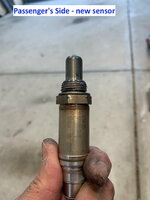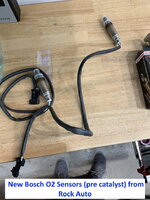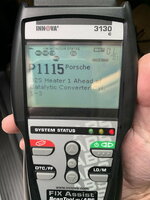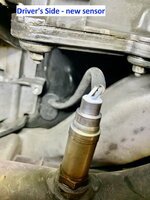Are they supposed to be tan? White?
I replaced my two pre-catalyst oxygen sensors on my sport beetle today. Bosch 13721 from Rock Auto. About $72 each. Torqued to 35 lb-ft. The new sensors came with anti-seize on the threads.




I did this at 60K miles / 26 years old to solve code P1115. Feels gratifying. Got to use my O2 sensor thread chaser tool, my el cheapo-crows-foot wrench to torque, and my fancy shmancy gearwrench 90T stubby 3/8" ratchet.





However, the two old O2 sensors had a coating of white on them, like so:


What does everyone else's old O2 sensors look like? I looked up "white 02 sensor" on Google and one possible culprit is silicone poisoning if a silicone adhesive was used somewhere in the engine. I've never used a silicone based adhesive, although I have no idea what a prior owner used. I wonder if the issue is a too-lean-mixture?
9 months ago I had to replace my MAF because some CEL code popped up that said my MAF was faulty and making the mixture too lean. I cannot remember what the code was exactly, but I remember reading about it and the Motronic adaptation was too far out and couldn't adapt for the excessive leanness .... so I replaced the MAF. After replacing the MAF 9 months ago, the “too lean” CEL code never came back. So ... I wonder if these old O2 sensors indicate the mixture was indeed too lean .... or if they look normal? Thanks.
I replaced my two pre-catalyst oxygen sensors on my sport beetle today. Bosch 13721 from Rock Auto. About $72 each. Torqued to 35 lb-ft. The new sensors came with anti-seize on the threads.




I did this at 60K miles / 26 years old to solve code P1115. Feels gratifying. Got to use my O2 sensor thread chaser tool, my el cheapo-crows-foot wrench to torque, and my fancy shmancy gearwrench 90T stubby 3/8" ratchet.





However, the two old O2 sensors had a coating of white on them, like so:


What does everyone else's old O2 sensors look like? I looked up "white 02 sensor" on Google and one possible culprit is silicone poisoning if a silicone adhesive was used somewhere in the engine. I've never used a silicone based adhesive, although I have no idea what a prior owner used. I wonder if the issue is a too-lean-mixture?
9 months ago I had to replace my MAF because some CEL code popped up that said my MAF was faulty and making the mixture too lean. I cannot remember what the code was exactly, but I remember reading about it and the Motronic adaptation was too far out and couldn't adapt for the excessive leanness .... so I replaced the MAF. After replacing the MAF 9 months ago, the “too lean” CEL code never came back. So ... I wonder if these old O2 sensors indicate the mixture was indeed too lean .... or if they look normal? Thanks.

